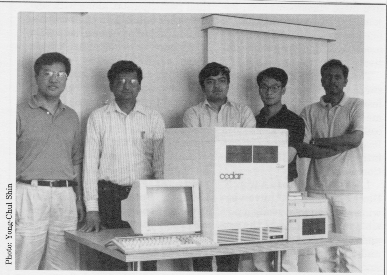

Volume 2 Fall 1994 Number 2

A new technology that can "read" the names and addresses on hand- and machine- printed tax forms, catch errors and make corrections -- all at the rate of about 8,500 forms per hour -- may be processing forms for the Internal Revenue Service (IRS) in 1995. Now being tested by the IRS, the Name and Address Block Reader (NABR) system was developed by computer scientists at the University at Buffalo's Center for Excellence for Document Analysis and Recognition (CEDAR). The internationally recognized center conducts research on one of the most difficult problems in artificial intelligence -- getting a computer to "read" handwriting and poor quality machine printing. Last year, after a round of competitive bidding among the UB group and major high-technology companies, the university center was selected by Grumman Corp. to develop NABR system. Grumman is the prime contractor on SCRIPS (Service Center Recognition Image Processing System), a comprehensive effort by the IRS to automate the processing of tax forms. "We found NABR to be the best solution," said William Kelly, SCRIPS program director at Grumman. "We liked its speed, its price and the group's ability to deliver the product on time." Four NABR systems are being tested at the IRS and one is being tested at Grumman. CEDAR, directed by Sargur Srihari, Ph.D., UB Professor of Computer Science, has devoted much of its research to developing technologies that recognize and read both printed and cursive handwriting for the US Postal Service, a principal source of the center's funding. NABR, which reads machine- and hand-printed characters, is based on technologies gained through the work CEDAR has done for the Postal Service over the past decade. For example, a key ingredient in the system is a postal service database that the UB researchers adapted for real-time application. With every post office box in the US, the database is the most comprehensive listing of residential addresses available. Kelly noted that by referring to the database in fractions of a second, the system can pick up and correct errors in addresses, such as misspelled state or city names and incorrect zip codes. Working under an accelerated schedule -- a system had to be ready in less than 12 months -- the scientist, under the direction of CEDAR project manager and senior research scientist Richard Fenrich, constructed NABR from existing computer boards used in a Sparc workstation. They then developed a new computer architecture by integrating six of the boards, a configuration that helps give the system its speed. The software to run NABR was also written by UB scientists. UB scientists and engineers at Grumman are now working on system improvements. "This system is at the limit of the technology," said Yong-Chul Shin, Ph.D., a research scientist at CEDAR and a member of the team that developed it. "But the entire architecture is scaleable, so we could add more processors for other, more demanding applications." Machine reading of other forms, such as those in banks and insurance companies, could also utilize such a system. The IRS expects to continue testing NABR for about another month. Plans are underway to begin using it to read names and addresses during the regular processing of tax forms starting next January.
![]()
![]()